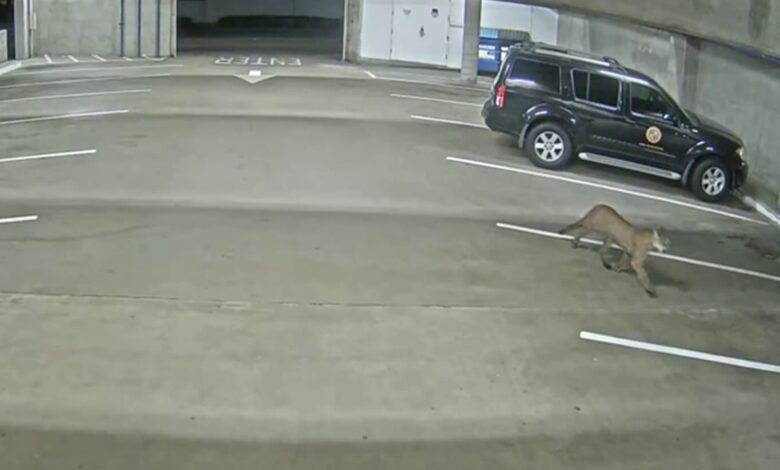Mountain lion killed in oceanside

Wildlife Tragedy in Oceanside: Cougar Struck and Killed
The quiet town of Oceanside was rocked by tragedy this week as a majestic cougar met a heartbreaking end. Join us as we delve into the details of this devastating wildlife incident and explore what it means for conservation efforts in the area. Let’s honor this beautiful creature together and work towards understanding and protecting our precious wildlife.
Introduction to the mountain lion killed in oceanside today
The coastal city of Oceanside, California is known for its beautiful beaches, charming small-town atmosphere, and thriving wildlife. However, in the early hours of Wednesday morning, tragedy struck when a cougar was struck and killed by a vehicle on one of the main roads in town.
According to eyewitnesses, the large “mountain lion killed in oceanside today” had been spotted roaming in the area for several days before the incident occurred. Many residents were initially excited about the rare sighting of such a magnificent creature in their neighborhood. However, as news spread about the cougar’s untimely death, shock and sadness quickly replaced excitement.
The tragic incident took place on Highway 101 near Oceanside Boulevard around 2:00 am. The driver who hit the cougar immediately pulled over and called local authorities for assistance. However, it was too late – upon arrival at the scene, animal control officers pronounced the cougar dead.
The cause of death was determined to be blunt force trauma from impact with the vehicle. It is estimated that the cougar was around three years old and weighed approximately 110 pounds. While cougars are not uncommon in California’s wilderness areas, this particular incident has left many wondering how this majestic animal ended up on a busy highway miles away from its natural habitat.
Further investigations revealed that due to recent wildfires in nearby canyons and mountains, many wild animals have been displaced from their homes and forced into more urbanized areas in search of food and shelter. Experts believe that this could be one possible explanation for why this young male cougar found itself wandering onto busy roads instead of staying within its usual habitat.
The tragic death of this beautiful creature has sparked conversations about human-wildlife interactions and how we can better coexist with these animals that call our state home. Wildlife officials have urged residents to exercise caution when driving through areas known to be frequented by wild animals and report any sightings or unusual behavior immediately.
As we mourn the loss of this cougar, let us also take this as a reminder to respect and protect the diverse wildlife that makes our state truly special. May we learn from this tragedy and take steps towards preserving the natural habitats of these animals for future generations to enjoy.
Background information on cougars and their habitat
Cougars, also known as mountain lions or pumas, are large and powerful wild cats that are native to North and South America. They are the second largest cat species in the Americas, after jaguars. These solitary predators have a muscular body, with short fur ranging from tan to reddish-brown in color. They have a distinctive long tail that helps them maintain balance while running and climbing.
Historically, cougars were found throughout most of North and South America, from Canada to Patagonia. However, due to human expansion and habitat destruction, their range has significantly decreased over the years. Today, they can be found primarily in remote areas of western North America and parts of Central and South America.
Cougars are adaptable animals that can thrive in different habitats such as forests, deserts, grasslands, and mountains. They prefer dense vegetation for cover while hunting but also require open spaces for stalking prey. In general, cougars prefer rugged terrain with steep cliffs or rocky outcroppings where they can hide during the day.
Their diet mainly consists of large mammals such as deer, elk, moose, bighorn sheep,and smaller prey like rabbits or rodents. Unlike other big cats who rely on their speed to take down prey,Cougars use stealth and ambush tactics to capture their food. They are able to take down prey much larger than themselves by using their powerful jaws and sharp claws.
Cougars play an essential role in maintaining ecosystem balance by controlling populations of herbivores like deer.Understanding this crucial role played by cougars highlights the importance of protecting their habitats.
Unfortunately,in recent years,cougar populations have been declining due to various factors including habitat loss,human encroachment,and poaching.Cougar-human interactions have also increased as urbanization expands into cougar territory,resulting in more conflicts between humans and these wild cats.While most cougars avoid contact with humans,there have been instances of attacks on people,especially in areas where their natural prey is scarce.
The tragic incident in Oceanside serves as a reminder that we must take steps to protect and preserve the habitats of these magnificent creatures. It is crucial to educate the public on coexisting with cougars and implementing measures to reduce human-cougar conflicts. By doing so, we can ensure the survival of this iconic species and maintain a healthy ecosystem for generations to come.
Details of the cougar’s sightings in the city
In recent years, the city of Oceanside has seen a rise in sightings of cougars. These majestic felines, also known as “mountain lion killed in oceanside” or pumas, have been spotted in various parts of the city, from residential areas to the outskirts near the mountains. While these sightings are not uncommon in areas with natural habitats for cougars, they have become more frequent and concerning in Oceanside.
One of the most notable incidents involving a cougar occurred just last week when a young male cougar was struck and mountain lion killed in oceanside by a vehicle on Highway 101. The tragic event not only resulted in the loss of an innocent animal’s life but also raised questions about why cougars are venturing into urban areas and how we can prevent such accidents from happening again.
According to local wildlife experts, cougars usually avoid human contact and prefer to live in remote areas with ample prey availability. However, due to factors such as habitat destruction and dwindling food sources, these animals are forced to adapt to changing environments and may sometimes wander into cities in search of food or territory.
In Oceanside, Mountain lion killed in oceanside today there have been multiple reports of cougar sightings near residential neighborhoods. In some cases, homeowners living near wooded areas or canyons have spotted these elusive creatures roaming their backyards or even preying on small pets. This has caused fear among residents who worry about their safety and that of their children.
To address this issue and protect both humans and wildlife, authorities have implemented measures such as educating residents on how to coexist peacefully with cougars, securing trash cans to prevent attracting them with potential food sources, and setting up barriers around schools and playgrounds where children may be at risk.
Despite these efforts, incidents like the recent tragedy on Highway 101 serve as a reminder that more needs to be done to protect both humans and wildlife from harm. Some conservationists suggest creating wildlife corridors – safe pathways for animals between fragmented habitats – could help reduce the chances of them venturing into urban areas.
While it is undoubtedly a tragedy when a cougar or any wild animal loses its life due to human activities, it also highlights the need for us to reassess our relationship with nature and find ways to coexist harmoniously. With proper education, awareness, and conservation efforts, we can ensure that cougars and other wildlife continue to thrive in their natural habitats without posing a threat to humans.
Explanation of how and why it was fatally struck by a car
The tragic death of a cougar in Oceanside has left the community reeling and questioning how such an event could occur. According to reports, the young male cougar was fatally struck by a car while attempting to cross a busy highway.
Experts believe that the reason this unfortunate incident occurred is due to a combination of factors, both human and environmental. The first factor being the increasing urbanization of Oceanside and its surrounding areas. As cities expand, they encroach upon natural habitats, forcing wildlife to adapt and find new territories. This inevitably leads animals like cougars to venture into more populated areas in search of food or suitable habitat.
Another contributing factor is the ever-growing number of vehicles on our roads. As more people move into suburban areas, there is bound to be an increase in traffic on major highways and thoroughfares. Unfortunately, this means that encounters between cars and wild animals are becoming more frequent.
In addition to these external factors, there are also human behaviors that can put wildlife at risk. For instance, speeding on highways or not paying attention while driving can make it difficult for drivers to react quickly enough when faced with sudden obstacles like an animal crossing the road.
Furthermore, authorities believe that this particular cougar may have been habituated to humans as it was often spotted near residential neighborhoods scavenging for food from trash cans or pet food left outside. This behavior could have led the animal to become less fearful of humans and therefore less likely to avoid them on busy roads.
In light of this tragedy, it is important for communities like Oceanside to take steps towards coexisting with wildlife safely. Some measures that can be taken include implementing lower speed limits in known wildlife crossing areas, installing fencing along highways or bridges specifically designed for animals’ safe passage, and educating residents about responsible waste management practices.
It’s also crucial for drivers to remain alert while behind the wheel and adhere strictly to speed limits in known wildlife areas. If an animal is spotted on the side of the road, it’s essential to slow down and give them the right of way.
While this fatal accident has saddened many, it serves as a reminder that we must make conscious efforts towards protecting our wildlife and creating safe habitats for them to thrive. By understanding how and why this tragedy occurred, we can take steps towards preventing similar incidents in the future.
Impact on local wildlife and community
The recent tragic incident of a cougar being struck and mountain lion killed in oceanside has not only affected the local wildlife but also the surrounding community. This unfortunate event has raised concerns about the impact of human activity on the delicate balance of nature and has sparked a conversation about conservation efforts.
One of the key impacts on local wildlife is the disruption of their natural habitat. As more urban areas are developed, animals are forced to adapt to new environments or risk facing extinction. The loss of natural habitats also means less food sources for these animals, leading them to venture into residential areas in search of food. This can result in conflicts with humans, as seen in the case of this cougar being hit by a car while crossing a busy road.
Additionally, accidents like this highlight the lack of awareness and education regarding coexisting with wildlife. Many people do not understand how their actions can affect wild animals and may unknowingly contribute to their harm. For instance, leaving trash cans open or feeding wild animals can attract them to human-populated areas, increasing their risk of getting into accidents or becoming dependent on human resources for survival.
The loss of top predators such as cougars can also have far-reaching consequences for the entire ecosystem. These apex predators play an important role in maintaining balance within their respective ecosystems by controlling prey populations and preventing overgrazing or destruction of vegetation. Without them, there could be a cascading effect that disrupts the entire food chain and impacts other species as well.
Moreover, incidents like this can have emotional effects on both locals and visitors who value wildlife sightings and interactions with these majestic creatures. Losing such an iconic animal can be disheartening for those who appreciate its presence in nature.
On a positive note, this tragedy has brought attention to conservation efforts and ways to protect our local wildlife. It serves as a reminder that we share this planet with various species and must take responsibility for preserving their habitats and ensuring their safety.
The impact of this cougar’s death goes beyond just one animal. It sheds light on the complex relationship between humans and wildlife and emphasizes the need for responsible actions to coexist harmoniously. Let us use this unfortunate event as a lesson to protect and preserve our natural world, for the sake of both wildlife and our communities.
Discussion on ways to prevent such incidents in the future
The tragic death of a cougar in Oceanside serves as a grim reminder of the increasing conflicts between humans and wildlife. Such incidents not only result in the loss of animal life but also pose a threat to public safety. It is essential to address these issues and take measures to prevent such incidents from happening in the future.
One of the primary ways to prevent similar tragedies is by promoting coexistence between humans and wildlife. This can be achieved through education and awareness programs, especially in areas where human-wildlife interactions are common. Educating individuals about the natural behaviors and habitats of animals can help them understand how to behave around them without provoking any conflict.
Another crucial aspect is proper management of human activities in natural habitats. As more and more people move into areas that were previously home to wildlife, it becomes necessary to establish guidelines for responsible behavior. This includes properly disposing of trash, avoiding feeding or approaching wild animals, and respecting their space.
In addition, implementing stricter laws and regulations for hunting or poaching can go a long way in protecting animal populations from unnecessary harm. It is important for authorities to enforce these laws effectively and impose strict penalties on offenders.
Creating safe corridors for wildlife movement is another effective strategy for preventing conflicts with humans. These corridors provide animals with safe passage through areas that have been developed by humans, reducing their chances of getting hit by vehicles or ending up in residential areas.
Furthermore, involving local communities in conservation efforts can also play a significant role in preventing future tragedies like the one in Oceanside. By working together with community members, conservation organizations can gather valuable insights on potential threats to wildlife and develop solutions accordingly.
It is also essential for individuals living near natural habitats to take preventive measures such as securing garbage cans, fencing off gardens or yards, and keeping pets indoors at night. These precautions not only protect domestic animals from becoming prey but also prevent wild animals from being attracted into residential areas.
Preventing tragic incidents involving wildlife requires a collective effort from individuals, communities, and authorities. By promoting coexistence, responsible behavior, and effective management of human activities in natural habitats, we can ensure that such tragedies do not occur in the future. It is our responsibility to protect and conserve wildlife for the benefit of both animals and humans alike.
The importance of coexisting with wild animals
The tragic death of a cougar in Oceanside is a stark reminder of the importance of coexisting with wild animals. While it may be tempting to view these creatures as a threat or nuisance, their presence is essential for maintaining healthy ecosystems.
One of the main reasons why it is crucial to coexist with wild animals is their role in regulating prey populations. Predators such as cougars help keep herbivore populations in check, preventing them from overgrazing and damaging plant communities. This, in turn, ensures a balance within the ecosystem and allows for the survival of various plant and animal species.
Moreover, wild animals also play a vital role in seed dispersal and pollination. Many plants rely on these animals to spread their seeds and facilitate reproduction. Without this process, entire plant communities could collapse, leading to devastating consequences for both wildlife and humans.
In addition to their ecological importance, wild animals also provide numerous benefits for human well-being. For example, ecotourism centered around observing these creatures in their natural habitats can bring economic opportunities to local communities while also raising awareness about conservation efforts.
Furthermore, many wild animal species have been studied by scientists who have discovered valuable medical treatments derived from compounds found in their bodies. The loss of these creatures could mean losing potential cures for diseases that currently have no treatment.
However, despite these benefits, conflicts between humans and wild animals often arise due to competition for resources or perceived threats to safety. In order to prevent such conflicts from escalating into tragedies like the one seen in Oceanside, it is crucial that we learn how to coexist peacefully with wildlife.
This can be achieved through various measures such as proper waste management practices that reduce the attraction of food sources for wild animals near human settlements. Additionally, creating designated protected areas where these creatures can thrive without interference from human activities is essential.
Education also plays a critical role in promoting peaceful coexistence with wild animals. By learning about the behavior and needs of these creatures, we can better understand how to live alongside them without causing harm.
The loss of a cougar in mountain lion killed in oceanside serves as a sad reminder of the importance of coexisting with wild animals. By recognizing their ecological significance, economic benefits, and potential medical contributions, we can work towards creating a harmonious relationship with these magnificent creatures.
Conclusion and call to action for responsible actions towards wildlife conservation.
The tragic death of the cougar in Oceanside serves as a stark reminder of the urgent need for responsible actions towards wildlife conservation. As humans continue to encroach on natural habitats and engage in activities that harm wild animals, it is our responsibility to take action and protect these creatures before it’s too late.
Firstly, it is crucial for individuals to educate themselves about wildlife conservation and the impact of their actions on the environment. This means staying informed about local conservation efforts, understanding the importance of biodiversity, and learning how small changes in daily habits can make a big difference. By raising awareness and sharing knowledge with others, we can collectively work towards creating a better future for both humans and wildlife.
Furthermore, responsible actions also involve making conscious choices when it comes to consumerism. Many products such as palm oil, paper, and wood are directly linked to deforestation and habitat destruction for wild animals. By opting for sustainable alternatives or supporting companies with ethical practices, we can reduce our impact on the environment and help preserve precious habitats.
In addition to individual efforts, government support is crucial in ensuring effective wildlife conservation. Laws protecting endangered species must be strictly enforced, penalties should be imposed on illegal poaching or hunting activities, and protected areas should be expanded to provide safe havens for wild animals. It is also necessary for governments to invest in research and funding towards conservation efforts.
Taking part in hands-on activities such as volunteering at wildlife rehabilitation centers or participating in beach cleanups can have a significant impact on preserving wildlife populations. These experiences not only help improve habitats but also raise awareness among communities.
The tragic death of the cougar in Oceanside highlights the fragile state of our natural world and calls upon us all to take responsible actions towards wildlife conservation. By educating ourselves, making conscious consumer choices, advocating for stronger government support, and actively participating in preservation efforts, we can make a positive impact and ensure a sustainable future for all living beings on this planet. Let us all unite in our efforts towards creating a world where wild animals can thrive and coexist with humans peacefully.
Read more about this website.



